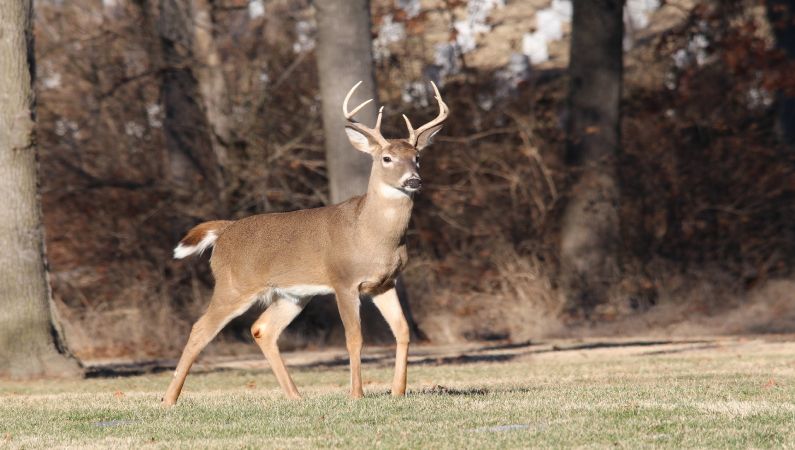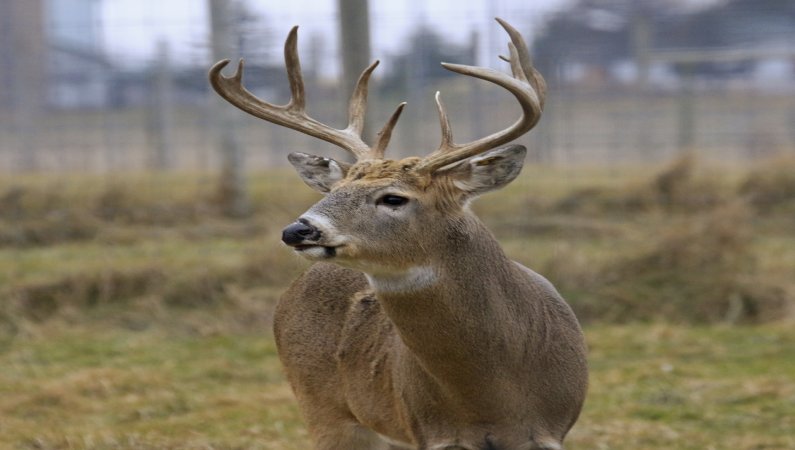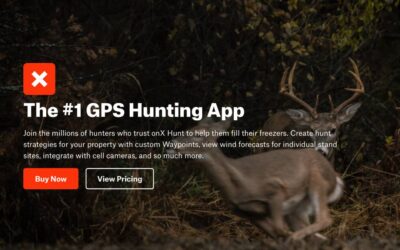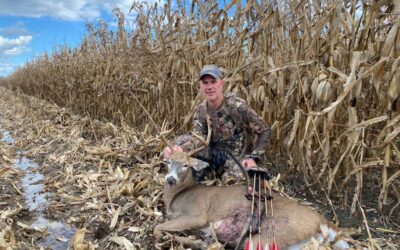This article may contain affiliate product links. I may receive a commission from sales. However, there is no extra cost to the buyer for using my affiliate link.
Using my affiliate links help support The Whitetail Teacher and allows me to deliver more content to help you become a better whitetail deer hunter.
November is the equivalent of “The Holiday Season” but for whitetail deer hunters. Rut hunting is an exciting time of the year in the whitetail woods.
Not because the deer are more patternable and easier to harvest. The exact opposite is true.
Everything that you think you know about a specific buck, throw it out the window because it is rut hunting time now. Anything can happen at any time of the day!
Rut hunting means that you need to take a different approach to your hunting strategies. That is why in this article you will learn strategies that will help you become successful during the best time of the year for whitetail hunting.
- Staging areas
- Funnels and Pinch Points
- Buck Scrapes
- Calling bucks to you
- What to do if you arent seeing any bucks
Rut Hunting in Staging Areas
Staging areas are a unique place to hunt for whitetail deer. Occasionally a staging area can be impossible to hunt.
However, there are a few times that a staging area will be huntable during the rut.
What is a staging area?
A staging area is a specific location or set of locations that a buck and doe will go to get away from the rest of the deer in the herd.
The buck wants to get the doe away from other bucks that can become competitive. The buck wants to make sure that he is the one that will breed this doe.
These staging areas tend to be in a very secluded and even odd place. I have seen a buck staging a doe in the middle of a cut corn field while I was rut hunting. They were in that field for 2 days.
This buck was not some small 6-point either. He was a nice wide 8-point. But why would that buck choose the middle of a field?
Those kinds of open areas allow the bucks to have a 360-degree field of vision. They will know exactly where an opposing buck or predator is coming from.
However, it is not ideal for us as whitetail deer hunters.
How long does staging last?
Staging can last a long time. It is hard to put a number on it because each buck and doe are different and unique.
It can be extremely frustrating if you are rut hunting and the buck you are chasing is in a staging area that you cannot access to hunt.
You do have a few options if you are rut hunting and you notice that a buck you want to harvest is staging a specific doe.
How to hunt a staging area
The best way to rut hunt in a staging area is to be able to access the staging area without being detected. If you can do that, you will be in good shape to use a calling sequence, a decoy, or just wait it out.
However, let us say that you cannot access the staging area undetected. Then what do you do?
It would be the best option to position your rut hunting spots where the deer have access to water or food.
Whitetail bucks do not sleep much during the rut. Yet, they still need to eat and drink to be able to survive.

Rut Hunting Funnels and Pinch Points
A funnel or pinch point is just two travel paths that many deer use and the two paths eventually turn into 1.
Many times the two paths are coming from two different areas and then they come together in a bedding area, water source, or some other resource that the deer need.
While rut hunting, watch for bucks to scent check these types of areas. They know that many does will use this area and they want to check if any hot doe has been in the area.
The bucks will normally do this on the downwind side of an area. If the wind direction is blowing out of the SouthEast, the buck will most likely use the NorthEast to the East side of the area. This allows them to use their nose instead of just relying on their eyes.
These spots can be a great place throughout the entire year; however, the rut is a time when you will see more bucks in these areas.
I like to use this strategy specifically right before the staging time normally happens. This allows me to catch a lot of the bucks that are trying to find a hot doe to breed.
Using Buck Scrapes while Rut Hunting
This strategy can be applied in both rut hunting and pre-rut hunting. A buck scrape can be used by both bucks and does to leave a scent behind and to communicate with the rest of the deer herd.
What bucks will do during the rut is to travel around a specific area and check their scrapes or scrapes that are new. This allows them to see if any hot doe has been through the area and may be ready to breed.
It also gives them an idea of other bucks that may have been in the area and hit that scrape.
While I am talking about buck scrapes, remember that deer are territorial animals and have a dominance hierarchy. It is odd to me how exactly it works but I know that it happens through scrapes, fights, and rubs.
What kind of Scrapes are good for rut hunting?
When looking for the right scrapes to hunt during the rut, you want to find the ‘red hot sign’. This can be done by in-season scouting at the right times or if you have cellular trail cameras. For in-season scouting, you want to find the freshest dirt that has been scraped.
If you are using cellular trail cameras, try to move them from summer and early season food to scrapes that are inside the woods or ditch line.
These scrapes tend to be more active during the rut than the ones that are on the edge of fields.
Use the data that you are receiving to make an educated hunting decision on where and how you want to hunt that specific area.
Hunting Over a Scrape during the Rut

Let’s talk about the position of your hunting spot over a buck scrape.
A common myth is that you have to be far away from the scrape on the downwind side because bucks make a j-hook.
A j-hook is just a fancy way of saying that the buck will make a half circle loop to the downwind side of the scrape before approaching it.
However, I do not really believe that this is always your best option. I think that you need to be able to make the shot if the buck is actively hitting the scrape.
In my mind, a better option would be to position yourself roughly 30 yards away from the scrape on the downwind side.
This gives the buck 29 yards to do his j-hook (if he pleases) without smelling you. But, it also gives you the ability to make your shot if the buck chooses to just hit the scrape.
That is how I like to use buck scrapes while rut hunting.
Calling Bucks to You
It is common knowledge that most hunters carry a rattle bag or rattling antlers and a grunt call. Even though many hunters have them, I do not believe many people use them or use them properly.
The key to using these pieces of gear is to learn how to communicate with deer. I know that can be scary because the rut is the best time of year and you do not want to mess up the natural flow of the woods, but if you are not using these two tools, you are missing out.
I started using the grunt call and rattle bag last year (2021). Here is what I found out.
- They work
- You do not need to be perfect
- You should have the best gear for calling
- Too much will equal no results
To start, I called in 3 different bucks in my 2021 hunting season. The first buck came in and he did not see what he heard.
Instead of coming closer to where the sound came from, that buck circled the woods and eventually left. Never came within 30 yards and a clear shot.
The second buck was a spike. He came within 10 yards. I chose not to harvest a spike.
The third buck did his thing and checked his scrapes after I made the calling sequence. He eventually came within 30 yards and gave me a clear shot. Well, I missed right over his back because of buck fever and miss judging the yardage. Tough luck.
I was not perfect by any means in my calling sequence. I messed up a couple of times and had some awful sound grunts. But it still worked.
After seeing the success I had, I looked deeper into calling systems. What I found out is that most grunt calls are way too aggressive.
You want to call in bigger bucks. So you do not want to make a grunting sound that sounds like the biggest and most mature buck. If you do that, all your younger (But still shooter bucks) will want no part in picking a fight with the top dog.
The rattling bag is just not a good choice because it is not realistic.
I eventually bought a new grunt call and a new set of rattling antlers to replace my rattle bag.
I went with the black rack and extinguisher from illusion calling systems. (Also backed by The Deer Society)
Do not overdo your calling sequences. This can make it obvious that it is not a real deer making those sounds. Try for something along the line of 5 minutes on 30 minutes off.
What To Do When You Are Not Seeing Bucks While Rut Hunting?
This happens to all of us. No matter how hard we try during the rut, we just cannot seem to find where the buck is located. I have good news.
They are probably in the staging phase of the rut that I talked about earlier.
You can combat this by finding where the does are bedding and feeding. If you can do that, you will eventually run into some bucks that are checking to see if any of them are ready to breed.
It is that simple. Find the does in the herd.
That is how you will see some more bucks while rut hunting if you find yourself in a rut (pun intended).
Conclusion
Rut hunting can be the most exciting time of the year for whitetail deer hunters. However, it can be chaotic and frustrating because there is no pattern or specific time that things can get crazy.
Try some of these rut hunting strategies for yourself and I think you will be pleasantly surprised at how many deer you will see. With a little bit of luck, you may just be able to harvest your target buck.
Enjoy the chaos because truly anything can happen at any moment during the rut.
Thank you for visiting The Whitetail Teacher! If you enjoyed this post, make sure to share it with a friend.
If you have any questions or recommendations for new blog posts, please use the contact form.
Learn, Plan, Execute,
The Whitetail Teacher




